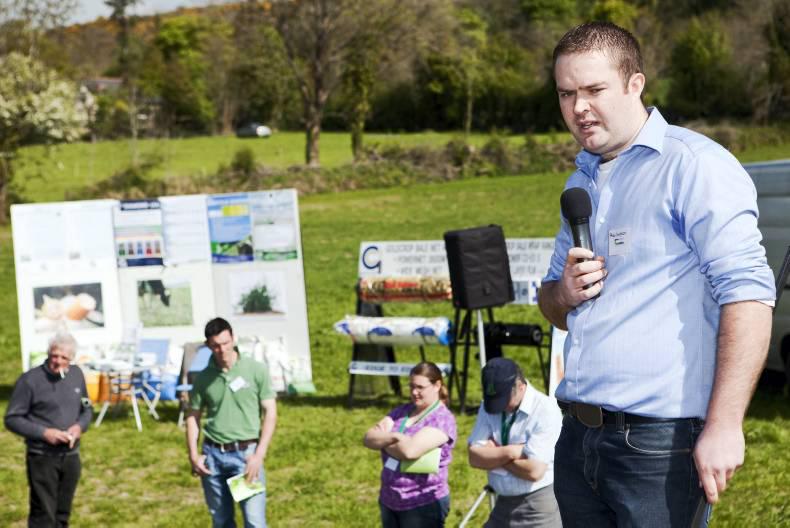Litter size in the Athenry demo flocks has averaged 1.75 to 1.8 lambs in the medium-prolificacy groups (Texel-cross and Suffolk-cross breeding) in recent years, while the three high-prolificacy groups have ranged from 2.05 to 2.15 lambs per ewe put to the ram.
As such, the high-prolificacy groups have averaged 18% of ewes carrying triplets, while medium prolificacy groups have averaged 10% since the flocks were formed.
There are no triplet-suckling ewes released outdoors, with surplus lambs removed and cross-fostered or artificially reared (along with orphan lambs from ewes with insufficient milk, individual cases of mortality, etc).
Flock researcher Philip Creighton says that while every effort is made to cross-foster, this is not always possible given the low number of single-bearing ewes within the defined groups and unfortunate timing of some births.
Management practices for triplet-bearing ewes start with adequate feeding to promote ewe colostrum production and ensure the birth of lambs with a favourable birthweight (target of 4kg plus) and good vigour.
Access to a high-energy, high-protein diet is viewed as essential. Philip says that the flock has been achieving good results from including soyabean at an inclusion rate of 25% to 30%. This year’s ewes are receiving concentrate with 28% soyabean (overall protein content of 19%), building up to 0.6kg, 0.8kg and 0.95kg in the final six, four and two weeks pre-lambing respectively.
Post-lambing
Lambs are assisted to suckle shortly after birth if required and are retained with the ewe for up to 48 hours to get the best balance between optimising colostrum intake and giving a chance to cross-foster direct from the ewe.
If cross-fostering has not occurred by 48 hours, one lamb is removed to a fresh lamb group.
Philip says that in previous years they left lambs with ewes for longer, but most cases resulted in the same outcome of one lamb being removed at a later stage, which delayed lambs taking to the milk feeder.
Lambs in this group are bottle-fed and trained to suckle the milk feeder. If an opportunity occurs, they can still be cross-fostered up until about four days of age. After this, the success of cross-fostering is significantly reduced.
At this stage, lambs are moved to a group where close monitoring takes place to ensure all lambs are suckling. Lambs showing low suckling activity and taking longer to adjust to the feeder may require a bottle feed to ensure nutritional intake is not compromised.
Philip says that once lambs are suckling sufficiently, there are generally very few, if any, problems.
The system in place differs to some conventional artificial rearing systems in that problem or orphan lambs that have been released outdoors as a single- or twin-suckling lamb may be joined with the group after a period of one to two weeks.
Philip says that these lambs take a lot longer to adjust to the feeder and while they generally do not lose weight, they take time to start performing. This also impacts on the average performance of the group.
Performance levels average 250g to 300g daily liveweight gain from birth to weaning, but Philip explains performance of the majority of lambs transferred on to the feeder at a young age exceeds 300g daily.
Indoor versus outdoor rearing
They experimented with two systems in the six flock groups. In both scenarios, lambs are fed milk replacer until six weeks of age and weaned once lambs are consuming 250g to 300g concentrates. Slightly cutting back the milk replacer allowance at four to five weeks of age will promote higher concentrate intake.
In the indoor system, lambs were built up to ad-lib meals consuming in the region of 600g by eight to nine weeks of age, 900g by 10 weeks and 1kg to 1.2kg after that.
In the outdoor system, animals were released outdoors post-weaning with access to creep feed of 600g to 700g daily. Lambs were grazed in rotation around four small paddocks.
Comparing the two systems, Philip says that lambs retained indoors consumed higher levels of meal (75kg to 85kg on average), but this was compensated for somewhat by earlier drafting and higher prices.
Performance in lambs released outdoors was variable, with some individual lambs gaining as low as 140g to 150g while others gained in excess of 250g daily.
While daily concentrate intake was reduced, lambs still consumed significant levels of meals due to a longer feeding period.
In the Athenry demo flocks, meal feeding was continued until lambs were drafted for sale, as there was no opportunity to join lambs with weaned suckling lambs due to the experimental nature of the flocks.
Pros and cons
Weighing up the advantages and disadvantages, Philip says that a decision on rearing essentially boils down to the farm’s circumstances and operator preference.
The direct cost of rearing lambs (milk replacer and feed) in both systems is estimated at about €58/head (€36/head milk replacer and €22/head meal cost) with variable costs differing thereafter (straw versus fertiliser, for example).
For farmers with high numbers and a ready-made setup for handling lambs indoors, this system works well as long as lambs are drafted while prices are high.
Outdoor rearing has the potential to lower costs if lambs are joined with weaned lambs on to a grass or forage crop diet.
The big disadvantage in this system is the cost associated with poorer- performing lambs with lambs at risk if farmgate prices have fallen.
On the plus side, lambs can be drafted at a lower weight achieving a 2% to 3% higher kill-out than lambs on a grass-only diet, while another constraint is that lambs released outdoors are often harder to handle or flock. Having access to top-quality grass is also vital, with the system working poorly if lambs are released to the same paddock from weaning to slaughter and supplemented with restricted concentrates.






 This is a subscriber-only article
This is a subscriber-only article






SHARING OPTIONS: